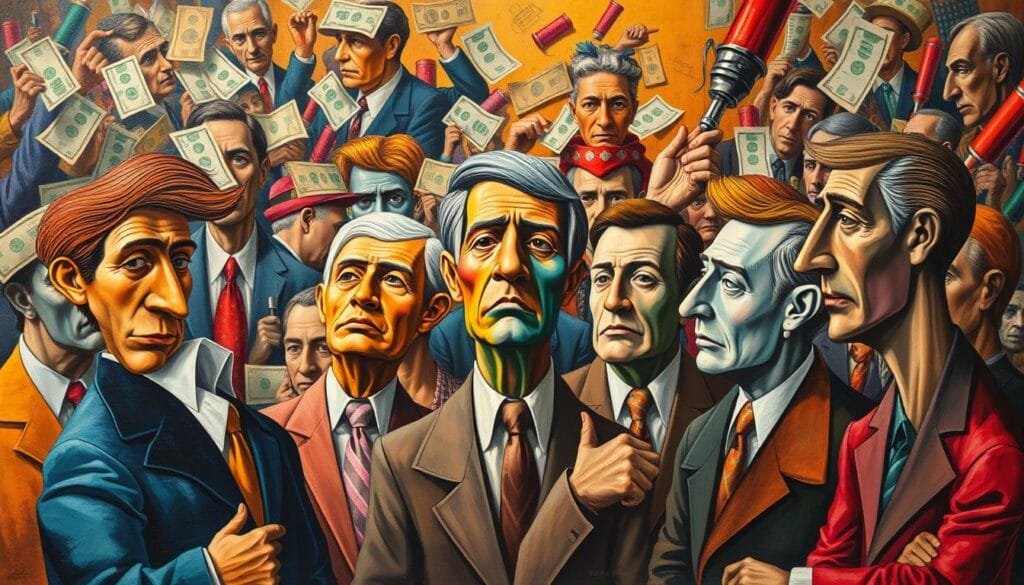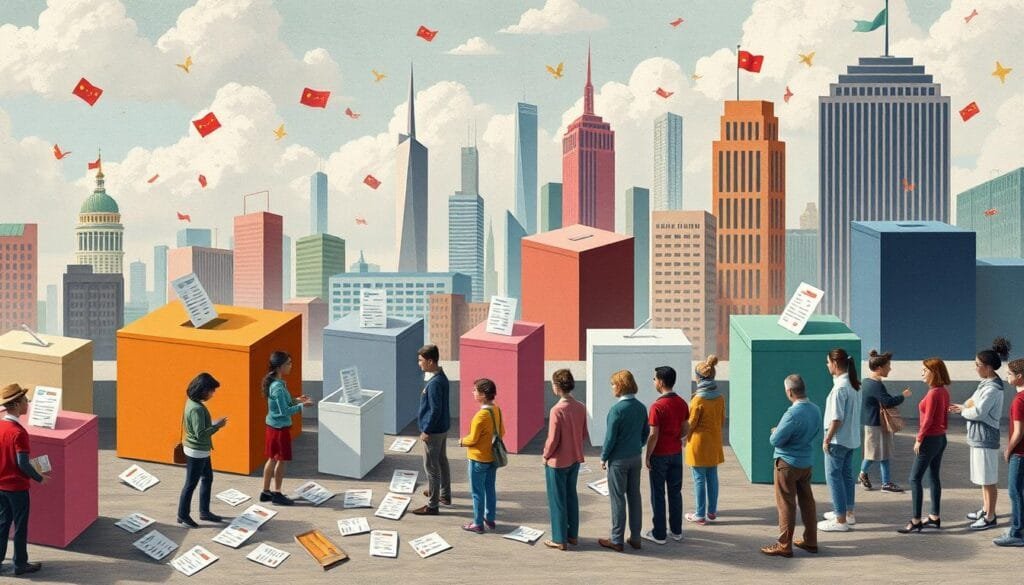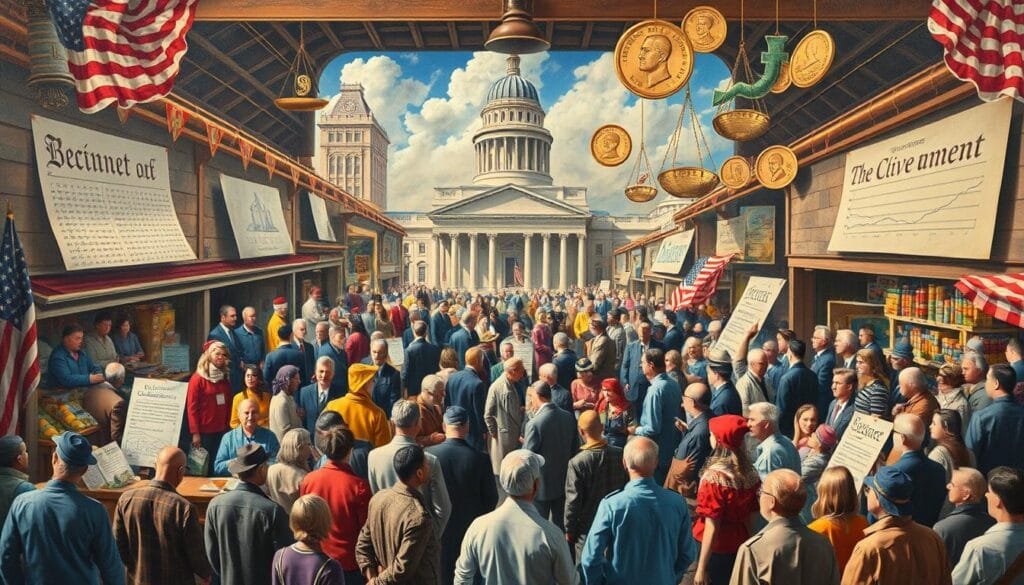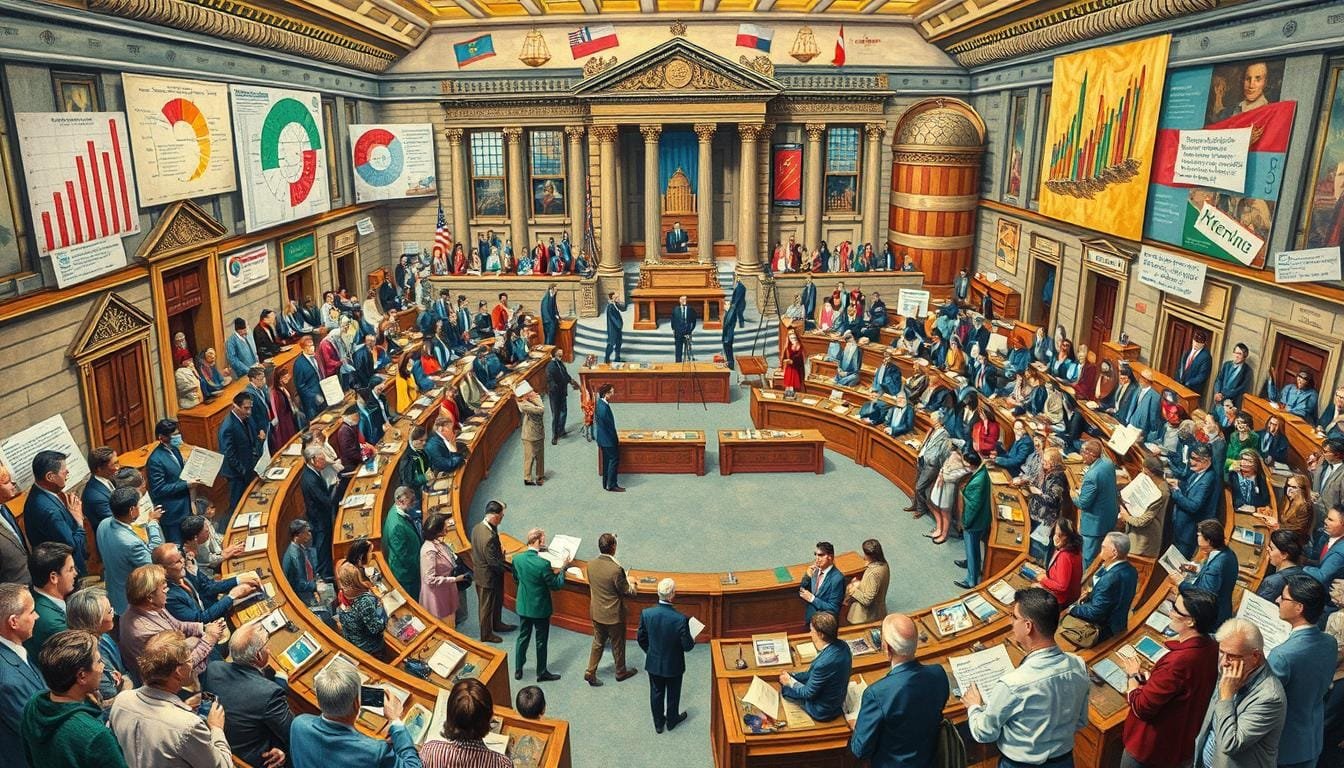What if officials make decisions based on self-interest rather than the public good? Public choice theory explains this mix of economics and politics. It shows us a new way to see political decisions. James M. Buchanan’s work, which won the 1986 Nobel Prize, questions the motives of politicians and voters. How does it link economic theories with political science?
Public choice theory uses economic ideas to study political actions. It looks at how personal goals and rewards influence group choices, often sidelining the common good. Kenneth J. Arrow’s “Social Choice and Individual Values” (1951) tells us it’s hard to fairly share resources without a dictator. And Anthony Downs’s “An Economic Theory of Democracy” (1957) explains why people often don’t research before voting. The chances of one vote changing an election are slim.
To grasp public choice theory’s challenges to old economic theories, let’s dive into its core ideas, voting systems, and special interest groups’ impact. “The Calculus of Consent” by Buchanan and Tullock (1962) is key to understanding how laws and politics affect society.
For detailed info on public choice theory’s beginnings and key concepts, check out the Economic Library’s website.
Key Takeaways
- Public choice theory applies economic principles to political science, emphasizing self-interest in political activities.
- James M. Buchanan was awarded the Nobel Prize for his contributions to this field.
- Kenneth J. Arrow and Anthony Downs made significant contributions to understanding voting behavior and social choice.
- “The Calculus of Consent” by Buchanan and Tullock is a landmark work in public choice theory.
- Public choice theory reveals how legislative processes are often influenced by special interest groups rather than the electorate’s overall beliefs.
- Rational ignorance among voters is rationalized by the minimal impact of individual votes on election outcomes.
Introduction to Public Choice Theory
Public Choice Theory explores public choice mechanisms using economic ideas. It looks at political behaviors in a new way. This method sees political people as self-interested agents, just like people in markets. They’re driven by their own goals, not just the public good.
In Western democracies, a big part of national output goes through political means, not markets. Thinkers like Kenneth Arrow and Duncan Black showed that democracy might not always work for the public interest. Arrow’s theory shows that elections can create cycles with no clear winners, which can make democracy unstable.
Wicksell suggested a move to unanimous decisions to make sure everyone benefits. This idea helps us understand how groups make choices together in democracies.
Tullock and Buchanan in “The Calculus of Consent” talked about two levels of politics. They explained how decisions at both levels affect us all. Their work shed light on how personal and group choices interplay.
The Public Choice Society and its journal were big steps forward. They helped spread the word about public choice studies. This idea spread to Europe and Asia, leading to more groups and journals in this field.
When we study rent-seeking, we see a key part of public choice. Tullock introduced it, and Anne Krueger named it. It’s about chasing benefits from the government that can lead to inefficiency and waste.
| Aspect | Outcome |
|---|---|
| Voting Benefit Equation | RP > C |
| Voter Turnout | Typically Very Low |
| Arrow’s Impossibility Theorem | Social welfare function derivation via political means is generally impossible |
| Principal-Agent Problem | Government employees may act contrary to public interest |
| Hotelling’s Model | Competition drives sellers to midpoint, diverging from social efficiency |
| Downs’ Political Application | Political candidates align with median voter position |
The study of public choice makes us think again about political institutions. It shows how these institutions often act like market players. Looking at politics this way helps us understand political actions better. It gives us insight into how people make decisions together in democracies.
Foundational Principles of Public Choice Theory
James Buchanan explored Public Choice Theory, which combines economics with politics. It focuses on the foundational principles that guide people in political environments. This theory stands out by stressing how self-interest in politics plays a huge role, just like in economic settings.

After World War II, countries used political means to use 33% to 50% of their products. This shift made it crucial to grasp how political decisions are made. Arrow’s “impossibility theorem” in 1951 found a big issue with democracy. It showed how using majority rule didn’t really help the public interest.
Majority cycles show why things can be unsettled, with election results always changing. Buchanan and others thought if everyone agreed in decisions, it would help everyone. But, this is hard to do in real votes because it can cause standstills.
Studies show lawmakers who ignore the people they serve for their own goals tend to lose the next election. This point is backed up by Bruce Bender and John R. Lott, Jr. In Japan, their voting system for multiple seats in an area shows how tricky it is to spread out votes in a party.
The balance between what the public and private sectors offer is influenced by how elections work. In democracies, people often want both individual gains and public services, like low taxes. This shows the complexity of what people want when it comes to politics.
| Concept | Key Insights |
|---|---|
| Foundational Principles | Public Choice Theory integrates economic analytical frameworks into political decision-making. |
| James Buchanan | Stressed the significance of personal interest driving political actions. |
| Self-Interest in Politics | Both voters and politicians act out of personal gain, akin to market behavior. |
| Arrow’s Impossibility Theorem | Demonstrates the inefficacy of majority rule in promoting general public interest. |
| Majority Cycles | Election outcomes fail to settle, reflecting inherent instability. |
| Unanimity and Super-Majorities | Ensuring net gains for all but challenging to achieve in practice, addressing minority protection. |
| Legislative Behavior | Ignoring constituent preferences often leads to electoral repercussions. |
The Institutions and Mechanisms of Public Choice
We need to know the different parts and steps in political decision-making. This includes voting systems and the median-voter theory. We’ll look at the main factors that affect how decisions are made by the public.
Voting Systems and Cycles
Voting systems are key to making public decisions, but they can be complicated. Arrow’s theorem shows the problems in making a group decision from individual choices. It says that no voting system can meet all the requirements for being fair and logical at the same time. We often see issues like voting cycles in real elections because of these limitations.

Interest groups use their power to influence politics by lobbying and campaigning. This can lead to policies that benefit some groups over others. When interests drive politics, voting systems might not work as intended, leading to unfair results.
Median-Voter Theorem
The median-voter theory helps us understand why democracy tends to end up with middle-of-the-road policies. Majority rule makes politicians aim for the center to win the most votes. This shapes the political field as candidates take moderate positions to attract more voters.
The theory also shows how voting strategies and not fully knowing everything can twist the real wishes of voters. Voters supporting the candidate they think can win might not reflect their true choices. This affects the position of the median voter and the policies that come out of an election.
Public choice theory talks about the importance of keeping political power in check to better represent the people. The changes it suggests focus on making government actions clearer and more answerable to the public, ensuring they better match what society wants.
| Concept | Description | Impact on Governance |
|---|---|---|
| Voting Systems | Mechanisms for collecting and deciding votes in electoral processes. | Potential for cyclical outcomes and inconsistencies. |
| Arrow’s Theorem | A theory outlining the limitations of fair collective decision-making. | Shows impossibility of creating a perfect voting system. |
| Median-Voter Theorem | Suggests outcomes reflect the preferences of the median voter. | Drives political candidates towards centrist positions. |
How Public Choice Differs from Traditional Theories
Public Choice Theory looks at things differently from traditional theories. It explores how individual choices and self-interest guide decision-making. Unlike traditional views that see outcomes as a group’s collective will, Public Choice focuses on personal choice.
Individual vs. Collective Decision-Making
Traditional theories focus on group decision-making. They assume the group’s wishes guide outcomes. Public Choice Theory, though, says individual choices come together to create results. It shows we need to look at each person’s decisions.
The impossibility theorem by Arrow shows a limit in collective decision-making. It says without certain rules, we can’t order social preferences clearly.
Majority cycles can show the challenges in group decisions. With three voters and three choices (A, B, C), odd results can happen. For instance, A beats B, B beats C, but then C beats A. It’s a cycle that points out the difficulties of stable group decisions.
Public vs. Private Choice Processes
Public Choice Theory also separates public and private decisions. Public decisions are swayed by political systems, aiming at group outcomes. On the other hand, private choices are about what individuals want, guided by markets. This theory explains how different motivations and limits impact the outcomes’ effectiveness and fairness.
| Aspect | Public Choice | Private Choice |
|---|---|---|
| Decision Motive | Collective benefit | Personal benefit |
| Incentives | Political influence, public welfare | Profit, personal preferences |
| Constraints | Government regulations, public opinion | Market competition, legal boundaries |
| Decision Framework | Voting systems, public policies | Market transactions, private negotiations |
The differences between public and private decisions show unique challenges. Public choice theory has changed our view of political and economic actions. It was shaped by thinkers like James M. Buchanan. Their work, like the “Calculus of Consent” published in 1962, remains influential.
What is Public Choice Theory Economics
This theory is a way to view political behavior through an economic lens. It shows how personal interests and the market shape political actions. Simply put, it uses economics to analyze politics.
James Buchanan and Gordon Tullock made this theory well-known. They wrote “The Calculus of Consent” in 1962. This book looks at political decisions through the lens of rational choice theory.
Public goods and common resources are key focuses. The theory uses economic models to study voters, politicians, and bureaucrats. It suggests these people act out of self-interest, which differs from the idea they’re just trying to help the public.

Public choice theory comes from many fields like public finance and game theory. Duncan Black’s work also helped shape it. This made way for new developments in the theory.
It ties into John Rawls’s idea of a society’s “second constitutional stage.” Rawls praised Buchanan at first but later found the theory too focused on individualism.
Over time, public choice theory has explained why people often distrust government action. It argues that we need to better understand government decisions. This opposes the view that government alone can fix economic issues.
James M. Buchanan won the Nobel Prize in 1986 for this theory. His work stressed the importance of looking at political processes with economic thinking. This helps us grasp the link between economics and politics better.
Critiques and Limitations of Public Choice Theory
Public Choice Theory has been closely examined for years. Despite its significant influence on political analysis, critics point out its flaws. They say it focuses too much on self-interest. This overlooks the depths of human motives and how groups make decisions.
Overemphasis on Self-Interest
One major critique is the theory’s heavy lean on self-interest. Nobel Prize winner James M. Buchanan believed politics is driven by economic self-interest, like in markets. But Lars Udehn, after thirty years of study, found evidence to the contrary. He noticed public choice doesn’t fully acknowledge altruistic and group-focused actions in politics.
The theory also suggests that “pork barrel” politics and legislative support are purely self-serving. This view oversimplifies the roles of values and ethics. It gives a skewed view of political motivations and how governance works.
Complexity of Modeling Collective Decisions
The difficulty of modeling politics within public choice theory is clear. It struggles with the varied and sometimes conflicting preferences of voters. Udehn points out that power and authority, ignored in this theory, are key in political decisions.
Also, the theory’s predictive models, like the median-voter theorem, often miss the mark. They can’t explain why so many vote in U.S. elections, even when one vote hardly affects the result. These challenges show the limits of public choice in understanding political behavior and group actions.
It’s essential to understand these critiques to build better models of politics. Recognizing the nuances and challenges of political decision-making can lead to more accurate and comprehensive theories. This will help us grasp governance’s complex nature and consider a wider range of human motivations.
Applications and Real-World Impacts
Public Choice Theory impacts various fields, allowing us to look at public policy analysis and voter behavior. By looking at real examples, we see how public choice principles shape policies and voter decisions.
Case Studies in Public Policy
Many cases show public choice’s role in policy analysis. For example, Gary Anderson (1990) noticed the public health sector often ignores public choice theories. Tollison and Wagner (1991) found similar issues. These examples reveal critical insights into how public health decisions are made.
Also, the high earnings of American doctors, noted by Friedman and Kuznets (1945), were due to the American Medical Association’s (AMA) rules. This shows how regulations can be manipulated.
| Publication | Content on Public Health |
|---|---|
| The Elgar Companion to Public Choice | 6 pages out of 600+ |
| The Encyclopedia of Public Choice | 12 pages in 1000+ pages |
Influence on Voter Behavior
The impact on voter behavior is key in public choice. The idea of rational ignorance explains why many voters aren’t fully informed. Getting informed is costly and seems not worth it. So, many voters don’t know much about the policies or candidates they back.
Expressive voting shows voters may choose based on personal beliefs or identity, not economic self-interest. This makes elections hard to predict.
Bureaucratic agencies often try to grow their budgets, leading to waste. Instead of meeting public needs, they focus on their own budget. This misuses resources.
Regulatory capture is when industries overly influence the bodies regulating them. This tilts policies in favor of industry, not the public. Public choice theory helps spot why policies fail and bureaucracies mismanage. It suggests using performance reviews and independent checks to fix these problems.
The roles of public choice in policy making and voter behavior show the challenges in politics and bureaucracy. It points out inefficient operations.
Conclusion
Public Choice Theory looks deep into political behavior, seeing self-interest as a big force. It uses the logic of economics to explain political actions. This shows why people and groups do what they do in politics. James Buchanan talked about politics as “politics without romance.” Kenneth Arrow said some choices can’t please everyone. This theory really makes us rethink how we view government and policy.
It shows how personal interests play into group decisions. The small chance of a vote changing an election makes us think more about why people vote. People often don’t learn everything about an issue because it takes a lot of time and usually, one vote doesn’t change much.
Public Choice Theory also looks at how special interest groups and lobbying shape policies. Often, these policies benefit a few while the cost is spread out to many. It points out the tricks used in politics, like trading favors and focusing on local gains over national good. This theory helps us see the flaws in how decisions are made in politics. It guides us to look for ways to make the process better and more fair.
FAQ
What is Public Choice Theory in economics?
Public Choice Theory is about using economic ideas to understand politics. It explores how people’s own interests and economic thinking affect political decisions. This idea is different from the belief that politicians mainly work for the public good.
Who is James Buchanan, and what is his role in Public Choice Theory?
James Buchanan played a big role in creating Public Choice Theory. He said that political choices are often based on personal interests, not just looking out for everyone. This idea shows that people act in politics the same way they do in the economy, seeking benefits for themselves.
How does Public Choice Theory view voting systems?
Public Choice Theory looks at how voting systems can have problems, as seen in Arrow’s impossibility theorem. It uses the median-voter theorem to explain that election results usually show what the middle voter wants. This affects both candidates and policies, making them aim for moderate views.
What is the main difference between Public Choice Theory and traditional political theories?
Unlike old theories, Public Choice Theory sees decisions as based on what’s best for individuals, not the group. It compares public and private choices, showing they’re made differently because of various influences and limits.
What are some critiques of Public Choice Theory?
Critics say Public Choice Theory focuses too much on self-gain, missing chances to see good deeds and complex group decisions. They point out the difficulties in modeling politics because it involves many different, often opposite, individual wants.
How is Public Choice Theory applied in analyzing public policies?
Public Choice Theory helps understand how political self-interest affects policies. Using it in analysis shows how personal gains can change policy decisions, leading to results that might not match the ideal public interest. It’s proven useful in studying voter behavior and policy impacts.
